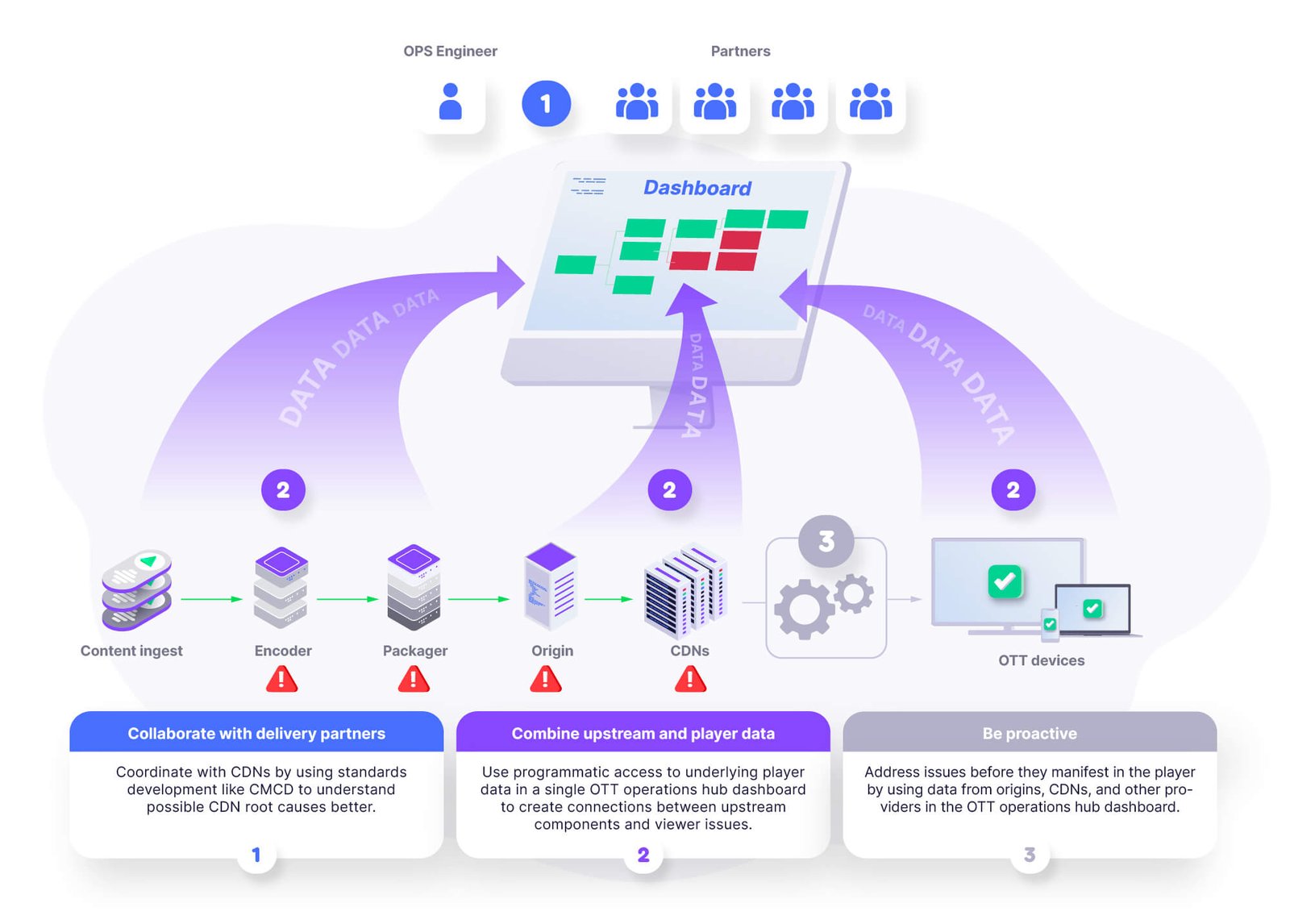
When streaming providers try to understand the experience of their viewers, they most often turn to player data as part of a data analytics function within operations. However, there are two problems with this approach.
The first is that analysing data from just the end of the workflow only tells you what's happening there, and it's a reactive approach that doesn't reveal the cause of anything. This is also the second problem: video analytics tools don’t provide a complete picture. Because they only represent the metrics gathered at the player, they don’t provide any means to solve the very problems they report.
If one of the metrics, such as time-to-first-byte (TTFB), reveals a value contributing to poor user experience, it can be difficult to determine the cause. The video analytics from the player do not necessarily indicate whether the issue is a local problem, such as a poor internet connection, or an upstream issue, like a CDN connection problem with an ISP. That’s why operations must look at more than just player analytics. To truly ensure a great viewer experience, they must be coordinated with upstream data. Resolving issues that impact QoE requires telemetry, which you can’t get with only half the data.
The first issue with relying just on video analytics: metrics vs data
It’s important to understand that we aren’t bashing video analytics. The data from the player provides important information about the viewer experience, which you can then use to extrapolate upstream issues. However, relying only on streaming video analytics, perhaps provided by a third-party SaaS solution, doesn’t give the needed granularity, even about what’s happening in the player. That’s because these analytics are often built on metrics rather than raw data. That is, what appears in the dashboard provided by the streaming analytics provider is already calculated. The numbers are often a combination of multiple data points. Although the metric may reveal player-level issues, the data behind it may not be readily accessible or even combined in a proprietary way. For operations engineers, that makes it even more difficult to connect what’s happening in the player to the upstream components.
Main issues with video analytics: more datasets, dashboards & complexity
Even though it is hard to break down video analytics into usable data for end-to-end observability, relying on video analytics alone to ensure a great quality of experience has other challenges and complexity for operations engineers. This makes it harder for them to quickly identify and solve issues. There are three main issues with relying on video analytics:
- It’s a separate datasource
- Analytics require their own dashboard
- Just numbers, not insights
It’s a separate datasource
Part of the main challenge is that because video analytics are often calculated before they are displayed in the dashboard, they are a separate data source. Operations engineers must figure out how to connect them, both programmatically and numerically, to the other data sources they use for issue detection and visualisation. Yet, it’s not just that it’s a separate data source that complicates video engineering. It’s the fact that it’s another source to contend with when video engineers are flooded with data sources already. According to the 2022 Bitmovin Video Developer Report, most video engineers admit to using at least four sources of data.
💡 You may like: Why You Must Monitor Streaming Data to Solve Fragmentation
Analytics require their own dashboard
On top of streaming video analytics being contained within a separate data source, they are also often visualised within their own dashboard. This creates a second level of separation and further complicates video operations engineers’ ability to quickly identify and resolve issues. Relying on video analytics simply adds another dashboard to an already growing number available on the walls of your NOC.
Just numbers, not insights
Perhaps the most pressing issue with video analytics is that they are just numbers, not insights. Because they are disconnected (as a datasource and within their own dashboard), they can’t provide insights about issues upstream. All they can report on is how the issues manifest within the player. As such, they don’t provide any actionable insights. Operations engineers can’t solve a problem with end devices.
How to enhance video analytics for superior issue resolution
Again, streaming video analytics aren’t bad, they just aren’t the only solution to identifying upstream issues from the player. Fortunately, there are a few approaches operations engineers can take to better fold video analytics into their issue resolution processes.
![]()

First is collaboration with delivery partners. Even if you can’t rely totally on video analytics, because they don’t reveal exactly what’s happening, it does provide a measure of understanding. For example, if there are a lot of issues with TTFB in a specific geography, it’s almost certain there is a delivery problem with one or more CDNs. Coordinating with those CDNs, then, is critical to understanding the root cause of those issues. Thankfully, standards development like CMCD, which provides more details within the player experience about individual CDNs, can be used as a means of collaboration with CDN partners.
The second is to create a combined approach with upstream and player data. Of course, that depends upon your analytics provider. If they can’t provide you programmatic access to the underlying player data, you’ll need to evaluate a different tool. Without the ability to pull in that data to a combined dashboard, a single OTT operations hub, you’ll never be able to create the connections between upstream components and the issues experienced by end viewers.
The last part of the approach is to be more proactive. A fundamental problem with video analytics is that addressing issues is reactive: you see the data, try to figure out the problem, and then solve it. All the while, viewers continue to experience the issue. In contrast, you can be more proactive when upstream component data, such as from origins, CDNs, and other providers, is combined in that OTT operations hub dashboard. You can potentially see and solve problems before they manifest in the player.
💡 Read more: Monitoring Harness Whitepaper
The impact of enhanced video analytics vs the old way
What happens when you take that different approach? When you combine the raw data underneath video analytics with upstream component data, collaborate with partners in that single dashboard, and when you can see issues proactively instead of reactively? The answer is simple: lower MTTD, lower MTTR, and high levels of viewer satisfaction. To ensure your streaming service meets viewer expectations for a high-quality video experience, operations engineers must address issues in the player proactively. The only way to do that is to ensure all the data is combined into a single dashboard and you are working with your key partners, like CDNs, to solve issues before they become part of your video analytics dataset.
Do more with your data with less effort, stress, cost, and time. Learn how Touchstream can help you combine upstream data with player data to be more proactive by requesting a demo now.
